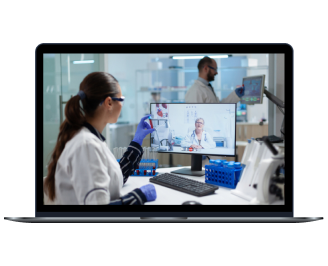IoT-based energy consumption optimization for a large manufacturer
See how we reduced utility costs and the environmental impact of a big manufacturer by 30% through implementation of a proof of concept (PoC) monitoring system that interacts with a large network of IoT sensors for real-time visualization of energy consumption.
-
Industry
Manufacturing
-
Country
USA
-
Team size
16
-
Collaboration
July 2021 – present
About the client
Our client is a large US-based manufacturer in the agricultural engineering industry that produces components for agricultural machinery.

Business context
A few years ago, our client shifted their business strategy towards environmental sustainability. To achieve this, they needed to implement proper energy resource management measures, including adopting energy monitoring software. The client opted for developing a custom solution to address all of their business needs and provide employees with a convenient and efficient work environment. As their partner, they chose Yalantis, a company that has expertise in delivering IIoT energy efficiency solutions.
.
Solution overview
-
Initiating accelerated solution development with the Yalantis PoC
To accelerate development, we relied on the ready-to-use Yalantis IoT Accelerator to create a solution aimed at assessing, analyzing, and forecasting utility resource waste overall and for each piece of the client’s equipment.
-
Deploying sensors to collect data
To prepare for sensor deployment, we developed a hardware prototype and built monitoring system software based on the PoC. Our client chose an IoT device vendor that used our hardware prototype to produce and install power sensors, current sensors, voltage sensors, and Wi-Fi communication sensors.
Power sensors:
- Hall effect sensors measure the magnetic field generated by current flowing through a conductor.
- Rogowski coils, wrapped around a conductor, measure the current passing through them without direct electrical contact.
- Current transformers (CTs) measure alternating current by inducing a current in a secondary coil proportional to the primary current.
Current sensors:
- Hall effect sensors measure the magnetic field generated by current flow.
- A shunt resistor measures the voltage drop across this field, which is proportional to the current.
Voltage sensors:
- Voltage dividers divide the voltage across a circuit into a measurable range.
- Analog voltage sensors measure voltage levels and provide an analog output that can be read by microcontrollers.
Wi-Fi communication sensors:
- Wi-Fi modules provide Wi-Fi connectivity to IoT devices and usually include microcontrollers and Wi-Fi transceivers.
- ESP8266/ESP32 modules integrate a microcontroller with built-in Wi-Fi capabilities.
-
Ensuring seamless data collection and aggregation
We established smooth data collection and aggregation processes that enable our client to regularly gather information from IoT devices and work with already processed data for faster analysis and decision-making:
- Gathering power, current, and voltage data from deployed sensors at regular intervals, such as every few seconds or minutes
- Aggregating collected sensor data and packaging it for transmission to the central monitoring system
- Using the MQTT protocol for efficient and reliable data transmission due to its publish–subscribe architecture suitable for IoT applications
- Using MQTT-enabled sensors for power, current, and voltage to directly transmit data to the MQTT broker
- Setting up an MQTT broker to act as a central hub for data communication that receives data from sensors and distributes it to appropriate subscribers
-
Implementing a central monitoring system
To enable access to data and comprehensive data analysis in one place, we developed a central monitoring system consisting of:
- A back end that subscribes to the MQTT broker and receives real-time power consumption data from sensors
- A database that stores data received from sensors over a period of time defined by the client for historical trend analysis, future reference, and demand planning
- A custom-built dashboard to visualize the real-time power consumption of each machine and the plant overall, enabling monitoring and management of excessive power use
- A predictive maintenance module based on ML algorithms to identify patterns, anomalies, and energy-saving opportunities
-
Designing a streamlined user interface
One of our client’s goals was to provide employees with a convenient workspace for managing and rapidly reacting to any changes. To achieve this, we:
- designed and developed streamlined web and mobile interfaces to access power consumption data, view real-time data and historical trends, and perform specific machine analytics
- built a notification center inside the monitoring system to alert relevant personnel of abnormal power consumption, energy waste, or equipment malfunctions
Value delivered
Our collaboration with the client resulted in the following achievements:
-
30% decrease in energy consumption. The client achieved their goal of improving plant sustainability and reducing environmental impact, establishing their leadership in eco-friendliness among competitors.
-
25% decrease in energy costs in the first half of the year. We helped the client reduce utility costs, allowing them to reinvest these savings in operational needs and equipment modernization.
-
Improved operational efficiency with predictive maintenance. Predictive maintenance enabled our client to detect and rapidly address machinery issues, reducing downtime and enhancing maintenance planning.
-
Customizable PoC monitoring system for large manufacturers. We developed a monitoring system capable of serving massive IoT environments, seamlessly gathering, aggregating, and analyzing data from IoT sensors in real time.
WANT TO IMPROVE OPERATIONAL EFFICIENCY?
Yalantis will help you select the most suitable IoT devices, establish secure real-time data collection and aggregation, and deliver a system for data management.
More projects
-
IoT network management platform
A SaaS device management platform that simplifies the setup and maintenance of large IoT networks
-
IoT-enhanced telehealth system
Integration with medical IoT devices for patient health monitoring during online cardiac rehabilitation sessions
-
Medical IoT solution
A telehealth system enhanced with a remote patient monitoring module and IoT technologies


